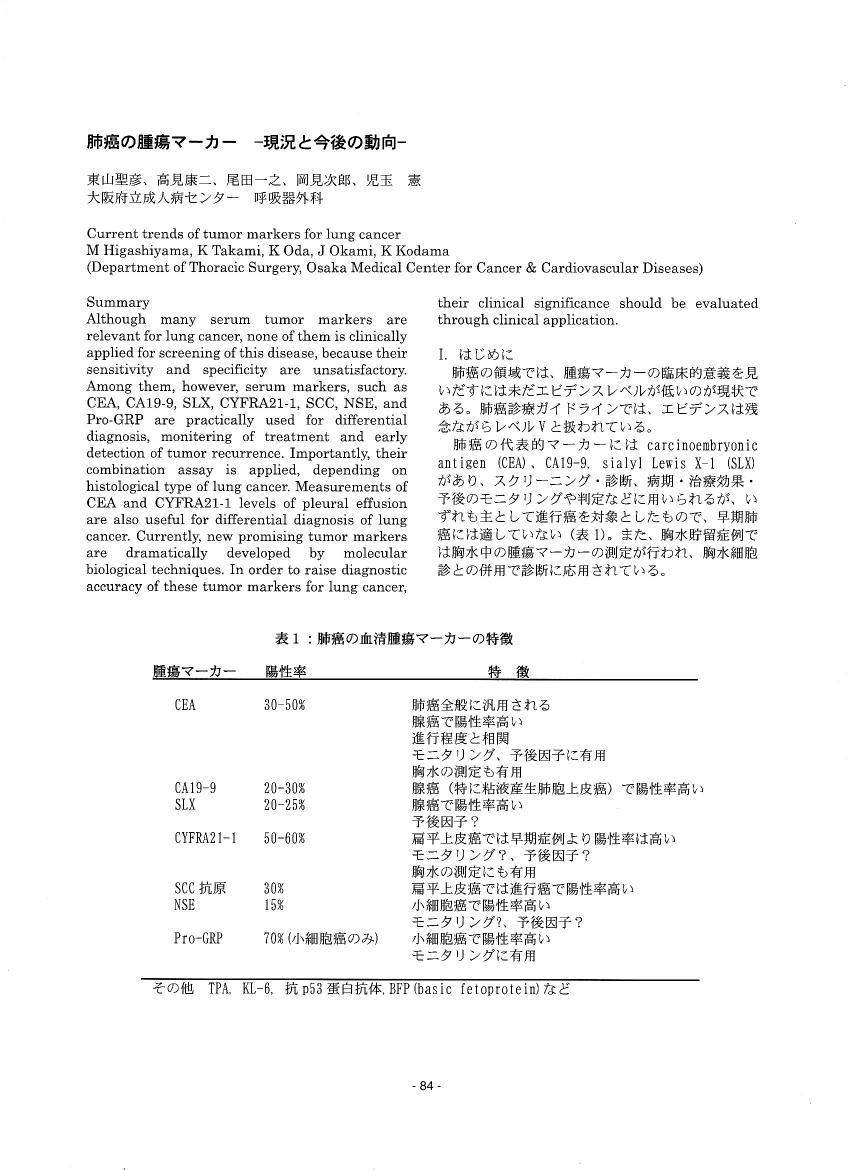3 0 0 0 OA 慢性ブロム中毒の存在が甲状腺クリーゼと誤認させたバセドウ病の1例
- 著者
- 児玉 憲一 夜西 麻椰 北川 奈津子 清水 彩永 江川 克哉
- 出版者
- 一般社団法人 日本プライマリ・ケア連合学会
- 雑誌
- 日本プライマリ・ケア連合学会誌 (ISSN:21852928)
- 巻号頁・発行日
- vol.46, no.3, pp.107-111, 2023-09-20 (Released:2023-09-22)
- 参考文献数
- 6
症例は50代,女性.頭痛,嘔気などを主訴に受診.血液検査での甲状腺中毒症及びTSHレセプター抗体陽性,甲状腺の超音波検査所見からバセドウ病と診断した.入院の上でチアマゾールにて治療を開始したが入院後に幻視や幻聴などの精神症状が出現し甲状腺クリーゼの診断基準を確実例として満たした.チアマゾール増量とヨウ化カリウム追加で対応したが,甲状腺機能改善下での精神症状出現に違和感を持った.血液検査を見直して気づいた偽性高クロール血症を端緒に市販のブロムワレリル尿素含有鎮痛薬乱用が判明,一連の精神症状は慢性ブロム中毒の離脱によるものが疑われた.向精神薬開始により精神症状は軽快,甲状腺機能については以降も順調に改善して退院した.甲状腺クリーゼは早期に疑い治療を開始すべき病態であるが,甲状腺疾患に精神症状を来す他疾患が併発すると診断基準偽陽性となることに注意が必要であると考える.
2 0 0 0 未利用樹種ネズの高付加価値化を含めた里山林バイオマス利用の再構築
- 著者
- 山場 淳史 児玉 憲昭
- 出版者
- 日本森林学会
- 雑誌
- 日本森林学会大会発表データベース
- 巻号頁・発行日
- vol.129, 2018
<p>広島県南部では元来,アカマツが優占する里山二次林が主要な植生景観であったが,現在ではそのほとんどが松枯れ被害を受け利用されないまま放置されている。部分的に市民・住民による維持管理作業が行われている箇所もあるものの,林業施策的にはほぼ取り残されている状態である。本報は,こうした地域における里山林利用を再構築する事例として,東広島市(旧黒瀬町・安芸津町を除く)と三原市大和町を所管する賀茂地方森林組合が主体となった取り組みを解説する。木の駅方式を一部取り入れ収集した木質バイオマスをチップ・ペレット化する拠点を整備するとともに,地域に立地する企業・団体の取り組み(小規模バイオマス発電や農畜産業など)と連携し地域内で循環することを目指している。併せて,その仕組みを補強し収益性をより高めるモデルとして,松枯れ跡林分に特徴的な未利用樹種ネズ(別名ネズミサシ:<i>Juniperus rigida</i>)の球果(香料)および幹材(木工用材)の新たな需要開拓を行い商品開発に繋げた過程を紹介する。そのうえで他地域との連携も含めた里山林利用の再構築のための将来的なフレームワークを提示する。</p>
2 0 0 0 性的パ-トナ-告知を促すHIVカウンセリングの技法と倫理に関して
- 著者
- 児玉 憲一 一円 禎紀
- 出版者
- 日本心理臨床学会 誠信書房(発売)
- 雑誌
- 心理臨床学研究 (ISSN:02891921)
- 巻号頁・発行日
- vol.15, no.1, pp.98-103, 1997-04
- 被引用文献数
- 1
1 0 0 0 OA 女子同性愛者のロールシャッハ検査所見 2 症例の特異な反応内容について
- 著者
- 児玉 憲典 阪本 良男
- 出版者
- 杏林医学会
- 雑誌
- 杏林医学会雑誌 (ISSN:03685829)
- 巻号頁・発行日
- vol.6, no.4, pp.221-231, 1975-12-30 (Released:2017-02-13)
性的倒錯者の中の同性愛者は, ロールシャッハ検査に, 特徴的な反応を示すことが知られている。しかし, その研究は, 大部分が男子同性愛者に関するものであり, 女子同性愛者のロールシャッハ検査の反応については, 推測の域を出ないというのが現状である。最近われわれは, 24歳と30歳の女子同性愛者の治療を行い, ロールシャッハ検査を行う機会を得たので, その詳細なプロトコルから, ロールシャッハ検査の反応内容が, 女子同性愛者の臨床像をどの程度反映するかについて検討した。その結果, 片口のロールシャッハ同性愛指標では, それほど高い得点は得られなかつたが, 男子同性愛者の場合と同様に, きわめて特徴のある反応が示された。
1 0 0 0 OA 肺癌の腫瘍マーカー ー現況と今後の動向ー
- 著者
- 東山 聖彦 高見 康二 尾田 一之 岡見 次郎 児玉 憲
- 出版者
- 日本分子腫瘍マーカー研究会
- 雑誌
- 日本分子腫瘍マーカー研究会誌 (ISSN:24338575)
- 巻号頁・発行日
- vol.20, pp.84-86, 2005 (Released:2005-08-29)
- 著者
- 笹原 健夫 児玉 憲一 上林 美保子
- 出版者
- 日本作物学会
- 雑誌
- 日本作物學會紀事 (ISSN:00111848)
- 巻号頁・発行日
- vol.51, no.1, pp.26-34, 1982-03-20
- 被引用文献数
- 6
Varietal Variations in the structure of ear and the size of grain were examined on thirty-two varieties, belonging to the different ecotypes. Five types of ear were classified principally based on the differences in number of grains on the secondary rachis-branch with the nodal position of the primary rachis-branch on a rachis (Fig. 1). Ear type I: The number of grains on the secondary rachis-branch was numerous in basal position of the car and became less towards the top of car. Ear type III: The number of grains on the secondary rachis-branch was also numerous in the middle position of car. And car type V: the number of grains on the secondary rachis-branch was numerous in the upper position of ear and became less towards the basal position. Two intermediate types, i.e., ear type II and IV were set in betwen type I and III, and type III and V, respectively. Indica varieties, which had larger total number of grains per ear than others, belonged to ear type III-V. Large grain varietics, which were larger in grain size than others, belonged to ear type I-II , and japonica cultivars belongcd to ear type I-III (Table 1, Fig. 2 and 3). The primary rachis-branch was numbered acropetally. The ratio of a nodal number of the primary rachis-branch having the maximum number of grains on the secondary rachis-branch to total number of the primary rachis-branch per ear was in the range of 4.3-3.8 in type I, 3.8-2.8 in type II, 2.6-1.9 in type III, 1.9-1.6 in type IV and below 1.6 in type V (Fig. 1). In a previous paper (SASAHARA, et al., 1982), it was reported that increasing rate of car weight at the maximum increasing period was higher in indica and large grain varieties than in japonica ones. Therefore, it may be concluded that indica varieties in which the grains on the secondary rachis-branch would have recieved the effect of apical dominance due to their abundant existence in the upper position of ear, and may result in increased rate of ear dry weight. On the other hand, in large grain varieties the less grain number in the upper position of ear could be compensated by the large grain size, resulting in high increasing rate of ear dry weight similar to indica varieties.
